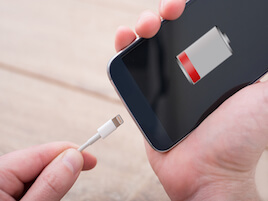
Is there anything more useless than a dead smartphone battery? Perhaps this is why nomophobia (that is, fear of being out of mobile phone contact) is the fastest growing phobia in the world. Here’s how to minimize the chance of a dead battery.
Dim Screen Brightness
Here’s something true for every make or model of smartphone out there: your smartphone’s bight screen is its biggest power draw. The brighter it is, the faster your battery drains. Try keeping your screen brightness at a lower level.
Disable Bluetooth
When Bluetooth is on, it’s always searching for a signal. This draws power. Unless you specifically need Bluetooth, keep it off at all times.
Manually Configure WiFi
Speaking of always searching for a signal, the same thing happens with WiFi. If you leave WiFi on, your phone will constantly search for any and every WiFi signal it can find. If you’re in transit or otherwise not connecting to WiFi, don’t let your phone search for a signal.
Ditch Push Email
Still on the subject of always searching for a signal, when your phone is constantly checking to see if you have email it’s using power. You can change your settings such that your phone will check every half hour, hour, or whatever. You can also just turn off push email and change your settings so that you manually fetch email. If someone really needs to speak to you, they can always call.
Reconsider Notifications
Notifications use up your power in two ways. If the app that’s sending you notifications needs to connect to the Internet, it’s using power to do so. Secondly, notifications chime and light up your screen, both draining power. There’s a notifications section in your phone’s settings. Go there and turn off everything non-essential. You can also edit notification such that apps only connect to the web when you’re connected to WiFi, thus saving your data. You can also prevent notifications after certain hours.
Exit Background Apps
Every app your phone uses draws power. If those apps are running in the background, they still draw power. It doesn’t matter that you aren’t using them presently. Some apps need to be always on. Most don’t though, so it’s best to turn them off.
On iOS, double tap your home screen and all the apps presently running will pop up. You can swipe to close them.
On Android, tap the multitasking button. This will let you swipe to close apps.
Decrease Screen Timeout
Screen timeout is when your screen dims after you use it. If it takes ten seconds for your screen to go black after you stop touching it, you have a ten-second screen timeout. Remember, every second your screen is lit is time it’s drawing power, so you can decrease your screen timeout to zero to save power.
Disable Vibration
Your phone rings and vibrates. But did you know that vibration takes more power than a regular audible ringtone? It’s true that sometimes you need a vibrating alert more than an audible one, but if you’re having lots of trouble with maintaining your smartphone battery all day, it may make sense to use vibrating ringtones only sparingly. Besides, in some contexts, like when your phone is sitting on a conference room table, a vibrating tone is pretty loud.
Get a Backup
If you’ve tinkered with your phone settings to squeeze as much power as possible but still need more, it’s time for a backup phone battery. There are dozens of models of backup battery out there, all of which are smaller and more powerful than they were even a year ago. Keep one in your laptop bag for ultimate piece of mind.

